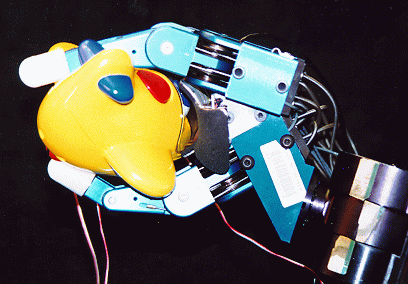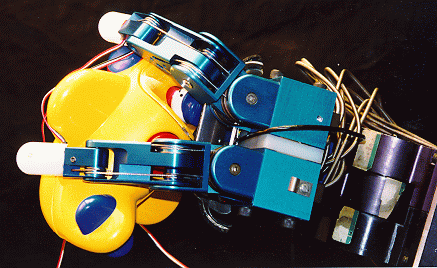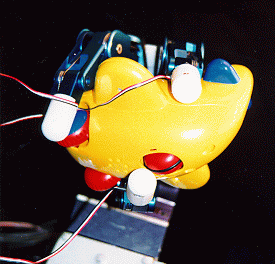![[Georgia Tech]](../../../animation/images/title_bars/GT.gif)
![[GVU]](../../../animation/images/title_bars/GVUbar.gif)
![[Animation lab]](../../../animation/images/animation.gif)
![[Search]](../../../animation/images/title_bars/magnify.gif)
![[Georgia Tech]](../../../animation/images/title_bars/GT.gif)
![[GVU]](../../../animation/images/title_bars/GVUbar.gif)
![[Animation lab]](../../../animation/images/animation.gif)
![[Search]](../../../animation/images/title_bars/magnify.gif)

Robotic hands are very flexible mechanisms. Because of this flexibility, it has been difficult to automate the process of acquiring objects using these robotic hands. Each new grasping problem is too complex to analyze without the use of good heuristics. Constraints due to target object geometry, environment geometry, hand kinematics and geometry, and a task description must all be considered when forming a solution.
One tempting approach to this problem is to contain the flexibility of the robot hand by developing standard routines for grasping common objects. Standard grasping routines greatly reduce the complexity of the grasp synthesis problem, but these routines tend to go too far, becoming inflexible to variation in the target object and environment geometries. If the range of application of any given grasping routine is small, a reasonably sized library of routines will not cover an acceptable space of problem situations.
My graduate research at MIT involved investigating one way in which standard grasping routines can be made more effective. A technique is developed for generalizing standard grasps and applying a generalized grasp description to new problem situations. The grasp generalization technique expands the range of application of a standard grasp to a wide variety of target object and environment geometries, while ensuring that the resulting grasps are appropriate for the intended task. The ability to generalize a standard grasp in this way greatly reduces the number of standard grasping routines that must be stored in any comprehensive grasp library.
A generalized grasp description is applied to a new problem situation using a parallel search through hand configuration space. The generalized grasp description allows the placement of each contact of a grasp to be independently optimized. This means that the process of assembling good hand configurations can be transformed into a dynamic programming algorithm. The many-dimensional space of hand configurations (fifteen dimensions for the Salisbury hand shown here) is searched for optimal solutions by performing a small number of steps in a six-dimensional workspace.
The result of applying a generalized grasp description to a new problem situation is a space of wrist configurations from which high quality, collision-free grasps can be achieved. It is useful to have such a global solution, because this solution can be used to estimate the robustness of a grasp to errors in wrist placement, to measure the effect of obstacles on the size and shape of the space of good grasps, and to indicate whether any good grasps are possible at all. A global solution also provides a flexible starting point for a post-processing step that adds the constraint of robot arm kinematics to the problem and finds an approach path into one of the high quality, collision-free grasps that have been identified.

Contact information:Nancy S. Pollard Graphics, Visualization & Usability Center College of Computing 801 Atlantic Drive Georgia Institute of Technology Atlanta, GA, 30332-0280 (404) 894-7243 E-mail : nsp@cc.gatech.edu |

|